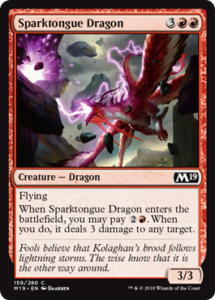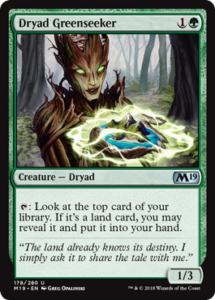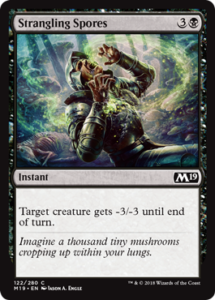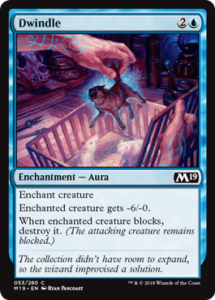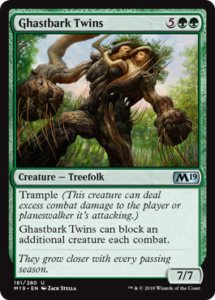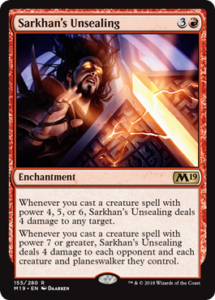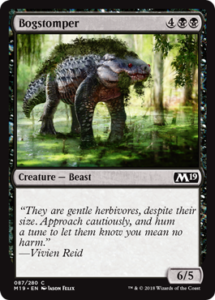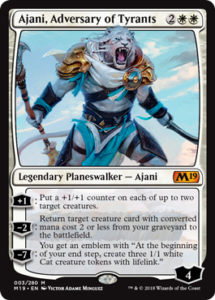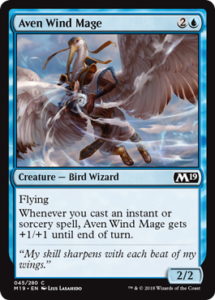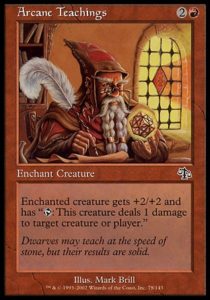Today’s article was inspired by a chat in the Hipsters Slack between Lexie and Carrie. They were discussing the crazy power level of Sparktongue Dragon, a common in Magic 2019 and it got me thinking about the designs of a host of cards in the set. We’ve got a lot of ground to cover, so let’s dig in!
Sparktongue Kavu-Dragon
Once upon a time, a 3/3 flier for five was among the best commons available; and red didn’t get solid flying creatures at common. A lot has changed. This is a strong common whose Kicker is just expensive enough that players are not going to feel compelled to wait for. I like that Sparktongue Dragon, like all spells with Kicker, is a simple lenticular design that invites Spike-y players to optimize its use.
The biggest thing that comes to my mind when considering this design is Lightning Shrieker, the common dragon from Fate Reforged. Dragons of Tarkir was the dragon set, but unlike Fate Reforged, it had zero dragons at common (though it did have an as-fan over 1 thanks to the preponderance of uncommon dragons). Scion of Ugin was almost a common, but R&D shifted it to uncommon because they didn’t want dragons smaller than 4/4 (even though there was a cycle of five uncommon 3/3 dragons with Megamorph). Sparktongue Dragon might not have been the ideal choice in a format of Megamorph creatures, but it demonstrates that design philosophies have changed and red can have its iconic creature at common and be aggressively costed.
Sindbad‘s back and better than ever
Fa’adiyah Seer has returned with way less clunky (and feel-bad) templating. Dryad Greenseeker is an exciting, powerful, and simple design. It blocks better than any two-mana looter (that lacks a cost to loot, like Research Assistant) and rather than looting, it just draws you a card a little less than half of the time. I love designs like this and Landfall, which let players be excited to have lands on top of their library, even when it’s later in the game. This is definitely going in my cube alongside Courser of Kruphix and Brainstorm.
Better than Fatal Fumes
Readers of Drawing Live might know that I’m a bit obsessed with mid-tier common removal, so it should come as no surprise that I’m excited to see Strangling Spores. It’s a simple, serviceable removal spell that doubles as a combat trick. It’s definitely less efficient than premium -X/-X removal black often gets at common (see Vicious Offering, Last Gasp, Splendid Agony), but Black doesn’t usually have two premium common removal spells and Lich’s Caress takes that slot. Strangling Spores is a simple combination of numbers we’ve seen before (with a truly gruesome flavor) that will still be a solid spell, even if it’s not the most efficient or powerful version. Sometimes things overall get better by some thing becoming worse.
How would this have fared in GDS3?
Dwindle is a very strange design. Obviously, blue gets effects like Pin to the Earth. But the second effect is black, right? Turns out, very, very little plays in this space. White has cards like Vanquish and Divine Verdict, and that’s about it. But still, it’s not like blue should claim “when enchanted creature blocks, destroy it,” right?
I’m rather bothered by the inelegance of the second ability—Dwindle isn’t a color pie break because it’s not shoring up a weakness of blue, but blue effects really aren’t supposed to destroy anything (setting aside the Polymorph debate). I get the flavor that Dwindle communicates, but does that really justify telling players—new and experienced alike—that blue gets to destroy things?
Words and actions matter in game design, and killing something via Dwindle is very, very similar to killing it via Claustrophobia. Why can’t this be an aura that says, “Enchanted creature has base power and toughness 1/1?” Perhaps that’s too complicated for common in a core set (or too much complexity to spend on this particular card), and I recognize that the design team created a cool, new removal spell that works in blue. I just don’t appreciate this particular execution.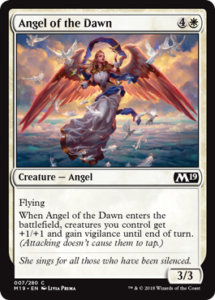
Not an angry bird, but an angel with bird-friends
I love Angel of the Dawn. Functionally, it’s identical to Dawnfeather Eagle, but the flavor of an angel’s arrival inspiring the troops makes much more sense to me than an eagle’s arrival (whose flavor text justifies its ability by it landing on Exquisite Archangel‘s arm). Dawn breaks, and with it comes hope is a solid trope. An angel bearing hope tells a story I enjoy. I’d save the eagles for LOTR.
Also, this is another iconic at common (along with Sparktongue Dragon). Dragons and Angels get to be common, whereas demons, sphinxes, and hydras really struggle to hit that mark—granted, they’re less resonant, less popular, and complicated in what they need to do.
White has to share the keywords
Ghastbark Twins and Greenwood Sentinel both have classically white abilities that have increasingly been shared with green over time. These designs communicate evolution to experienced players and give a strong introduction to the colors’ abilities to newer players.
A story for those who know it
Oh. Oh my. It took three planeswalkers to unseal the Eldrazi on Zendikar: they were Jace, the Mind Sculptor, Sarkhan the Mad, and Chandra Ablaze. Four, five, and six. This summoned the Eldrazi, who were Not of This World.
Sarkhan’s Unsealing presents a very nifty mechanical quest, a style of effect we’ve started seeing on cards like Imminent Doom. There is a real deckbuilding cost in that you need a very high curve and it serves only to make your most powerful cards better; but this is a card that Jennies, Mels, and Vorthoses might fall in love with.
The black Alpha Tyrranax
I love this weird creature. It communicates that black occupies a spot in nature, something green obviously gets loads of, but we see white birds, blue fish, and red hellions much more often than we see living black animals.
Resurrecting, er, getting a friend
The second ability on Ajani, Adversary of Tyrants is perfectly in-color for white, but a very odd fit for Ajani. His power set is entirely about buffing other creatures. Even though he is a healer, resurrecting the dead has become a weirder thematic niche for white to occupy, particularly given how flavorful and obvious black is when it Reanimates the dead.
Rosewater commented as such in the Magic 2019 M-Files:
The second ability is a way for him to recruit more creatures to fight with you using a white ability that he’s never used before. The flavor isn’t resurrection, just that he’s getting another ally similar to one he already had. The limit to the smaller size is because that’s the limitation in white for reanimation.
I feel like my criticism of Dwindle applies here, as well. Performative actions matter, and taking the same card out of your graveyard that died last turn and putting it back onto the battlefield feels a whole lot like reanimation, particularly when you’re a player who doesn’t yet know that cards that change zones have no memory of their previous existence. The solution which readily came to mind, however, is far worse than the tweak I’d have made to Dwindle. We’ve seen technology like this in Embalm and Dauntless Cathar, where you’re clearly getting something distinct from the original creature. However, complex token-making takes too much text on an already-stuffed card and isn’t easy to represent.
Perhaps the name of the card could have communicated that this is Ajani, Summoner of Allies, but then that would have undermined that this is Ajani back when he was fighting Bolas on Alara. I don’t feel quite as critical of Ajani’s design as I do Dwindle, but I still wish it could communicate Ajani summoning allies—particularly when Ajani, Mentor of Heroes does it so well.
So long, Prowess!
Aven Wind Mage is a clean upgrade on Wind Drake, a card whose stock has fallen rather far. It cleanly communicates that a blue archetype cares about instants and sorceries, allowing players to discover the wonders of blue-red. What I’d love to talk about is why Aven Wind Mage lacks Prowess, the ability it essentially has.
Prowess is a fairly weak ability (which isn’t a bad thing, if anything, it makes it easy to develop and balance). It’s not shown up that often since becoming an evergreen keyword and its future doesn’t look bright. It turns out that Prowess can contort entire formats around itself. It’s good if you want a U/x archetype built around Prowess, but bad when suddenly blue needs Prowess support every single set. I appreciate the experiment of Prowess being evergreen, but I wouldn’t be surprised if it’s downgraded to deciduous (or nothing).
I wish I’d had time to cover more, so before parting ways, here’re a few cards I didn’t have time to get to:
Metamorphic Alteration—beautifully simple design. An awesome Polymorph variant.
Liliana, Untouched by Death—a super niche Liliana that unlike Liliana of the Dark Realms is totally on-theme.
Arcane Encylopedia—Jayemdae Tome ain’t good enough anymore. This probably isn’t, either, unless the format’s really slow.
Meteor Golem—Scour from Existence, now falling on you from the heavens. I love it.
Transmogrifying Wand—it’s not quite Ovinomancer, but it’ll still give Bruse Tarl, Boorish Herder an awful week.
And that’s all for this week! Thanks for joining me on this trip through Magic 2019’s cards; and, as always, thanks for reading.
—Zachary Barash
Zachary Barash is a New York City-based game designer. He works for Kingdom Death: Monster, has a Game Design MFA from the NYU Game Center, and does freelance game design. When the stars align, he streams Magic.
His favorite card of the month is Metamorphic Alteration. It’s a Clone that you can deploy to Polymorph your opponent’s creature or upgrade your own. It’s not a strong card in and of itself, but it can enable a whole host of shenanigans.

